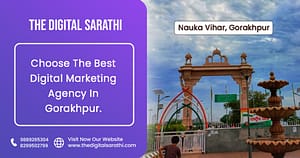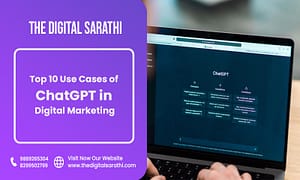Fundamentals of Digital Marketing encompass the strategic use of electronic devices by marketers to deliver promotional messages and measure their impact throughout the customer journey. In practice, digital marketing primarily focuses on campaigns appearing on computers, phones, tablets, and similar devices. It encompasses various formats like online video, display advertising, search engine marketing, paid social advertising, and social media postings. Comparatively, digital marketing differs from “traditional marketing” methods such as magazine ads, billboards, and direct mail. Interestingly, television is often categorized under traditional marketing rather than the fundamentals of digital marketing.
Did you know that more than three-quarters of India are online every day? In addition, 43% are online more than once a day and 26% are “almost always” online. For mobile internet users, these numbers are even higher. 89% of Indians are online at least every day, and 31% are almost always online. As a marketer, it’s important to leverage the digital world with your online advertising presence, build your brand, and deliver a great customer experience with your digital strategy to reach more potential customers.
Moreover, we can say Digital Marketing, also known as Online Marketing, is a brand promotion to connect with potential customers via the Internet and other forms of digital communication. This includes email, social media and web-based advertising, as well as text and multimedia messages as marketing channels. If your marketing campaign includes digital communication, it’s essentially digital marketing.
What is Inbound Marketing and how it is different from Digital Marketing?
Digital Marketing and Inbound Marketing are easily confused and for a good reason. Digital marketing uses many of the same tools as inbound marketing. For example, email or online content. Both help attracts the attention of potential customers and turns them into customers on the buyer’s journey.
However, the two approaches have different views on the relationship between tools and goals.
- Digital marketing considers how individual tools can change prospects. Your brand’s digital marketing strategy can leverage multiple platforms or focus all your efforts on one platform.
- Inbound marketing is a holistic concept. First, check your goals, then the tools available to determine which target customers are effectively reaching, and then at what stage of the sales goal-reaching process you’ll reach them.
The most important thing to know about digital marketing and inbound marketing is that you don’t have to choose between the two as a marketer. They work best together. Inbound marketing provides an effective digital marketing structure and objectives for your digital marketing efforts and ensures that each digital marketing channel is working towards your goals.
What are B2B and B2C Digital Marketing?
Digital Marketing works for both B2B and B2C companies, but best practices differ significantly between the two.
B2B customers tend to have a longer decision-making process, which in turn has a longer sales funnel. Relationship-building strategies are more effective for these customers, but B2C customers are more sensitive to short-term offers and news.
B2B transactions are usually based on the logic and evidence presented by experienced B2B digital marketers.
B2C content is more emotional and focuses on making customers feel better about their purchases.
The B2B decision usually requires input from multiple people. The marketing materials that most facilitate these decisions are usually available for sharing and download.
B2C customers, on the other hand, prefer a one-to-one connection with the brand. Of course, there are exceptions to all rules. B2C companies dealing with high-priced items such as cars and computers may offer more informative and legitimate content. Your strategy, be it B2B or B2C, must always be in line with your customer base.

Types of Digital Marketing
Digital marketing has as many disciplines as how to interact with digital media. Here are some important examples.
- Search Engine Optimization
Search Engine Optimization or SEO is technically a marketing tool rather than a form of marketing itself. Balance defines it as “the art and science that makes a website attractive to search engines.”
The “arts and sciences” part of SEO is the most important. SEO is science. To get the best possible ranking, you need to investigate and weigh different factors.
Here are some of the most important factors to consider when optimizing your website today:- Content Quality
- User Engagement Level
- Mobile Friendly
- Number and Quality of Incoming Links
- Strategic use of these elements makes SEO a science, but unpredictable art.
SEO has no quantifiable rubrics or consistent rules to rank high. Google is almost constantly changing its algorithms, so it’s impossible to make accurate predictions. What you can do is carefully monitor the performance of your site and adjust accordingly.
- Content Marketing
SEO is a key element of content marketing and is a strategy based on delivering relevant and valuable content to your target audience. As with any marketing strategy, the goal of content marketing is to win leads that ultimately lead to your customers. But it’s very different from traditional advertising. Instead of seducing potential value prospects from a product or service, it offers free value in the form of written material.
Content marketing is important and there are many statistics to support it :- 84% of consumers expect businesses to provide a fun and useful content experience.
- 62% of companies with more than 5,000 employees produce content daily.
- 92% of marketers believe that their business values content as an important asset.
Content marketing is effective, but it can be tricky. Content marketing writers need to be able to rank high in search engine results while attracting people who read, share, and interact with their brands. If your content is relevant, you can build strong relationships across your pipeline.
- Social Media Marketing
Social Media Marketing aims to increase traffic and brand awareness by engaging people online in discussions. The most popular social media marketing platforms are Facebook, Twitter and Instagram, followed by LinkedIn and YouTube.
Social media marketing has become a popular way to get attention because it involves active audience participation.
Social media marketing provides built-in engagement metrics to help you understand how well you reach your audience. You can determine which type of interaction is most important, such as the number of shares, the number of comments, and the number of clicks across your website.
- Pay-per-click marketing
Pay-per-click (PPC) places ads on the platform and pays every time someone clicks. When and how people see your ads is a bit more complicated. When a spot on a search engine results page (also known as SERP) becomes available, the search engine fills the spot with an essentially instant auction. The algorithm prioritizes each available ad based on many factors, including:- Ad Quality
- Keyword Relevance and Research
- Landing Page Quality
- Bid
Each PPC campaign has one or more targeted actions that viewers must perform after clicking on an ad. These actions are called transformations and can be transactional or non-transactional. Purchases are conversions, but so are newsletter subscriptions and home office calls. Whatever you choose to convert your goals, you can track them across the selected platform to see your campaign’s performance.
- Affiliate Marketing
Affiliate Marketing allows someone to make money by promoting the business of others. You can be either a promoter or a company that works with a promoter, but the process is the same in both cases.
Works with the revenue sharing model. If you are an affiliate, you will receive a commission every time someone buys the item you are promoting. If you are a merchant, you pay affiliates for all the sales they help you get. Some affiliate marketers probably choose to review only one company’s products on blogs and other third-party sites. Others have relationships with multiple dealers.
- Native Advertising
Native Advertising is disguised marketing. The goal is to blend in with the surrounding content and make it less noticeable than advertising. Native advertising was developed in response to today’s consumer ridicule about advertising. Knowing that the creator of the ad is paying to do it, many consumers conclude that the ad is biased and ignore it as a result. Native advertising avoids this bias by providing information or entertainment before promoting and disregarding the “promotional” aspect.
- Marketing automation
Marketing automation uses software to power digital marketing campaigns, improving the efficiency and relevance of advertising.
According to statistics:- 90% of Indian consumers find personalization either “very” or “somewhat” appealing.
- 81% of consumers would like the brands they engage with to understand them better.
- 77% of companies believe in the value of real-time personalization, yet 60% struggle with it.
Marketing automation lets companies keep up with the expectation of personalization. It allows brands to:
- Collect and analyze consumer information
- Design targeted marketing campaigns
- Send and post-marketing messages at the right times to the right audiences
- Email Marketing
The concept of email marketing is simple. Send a promotional message and expect potential customers to click on it. However, the execution is much more complicated. First, you need to make sure your email is legal. This means having an opt-in list that does the following:- Individualize content by both body and subject Indicate the type of email the subscriber is receiving.
- Email signature that provides a clear unsubscribe option.
- Both integrated transaction email and promotional email.
We want prospects to see the campaign as a valuable service, not just a promotional tool. Email marketing is a proven and effective technique in itself. 89% of the experts surveyed list email marketing as the most effective lead generator.
Overall, digital marketing greatly improves the flexibility of advertising costs and customer contact. Traditionally, every customer has the option of asking “how did you find us?” Unfortunately, this does not work in all sectors. Many companies are unable to have one-on-one conversations with their customers, and surveys do not always provide complete results. It’s easy to track success with digital marketing. Digital marketing software and platforms automatically track the number of conversions you want, including email open rates, homepage visits, and direct purchases. Digital Marketing allows you to click a link or save your blog post to quickly move up the sales goal achievement process. They may not buy immediately, but they will keep you in touch and allow you to continue interacting with them.



